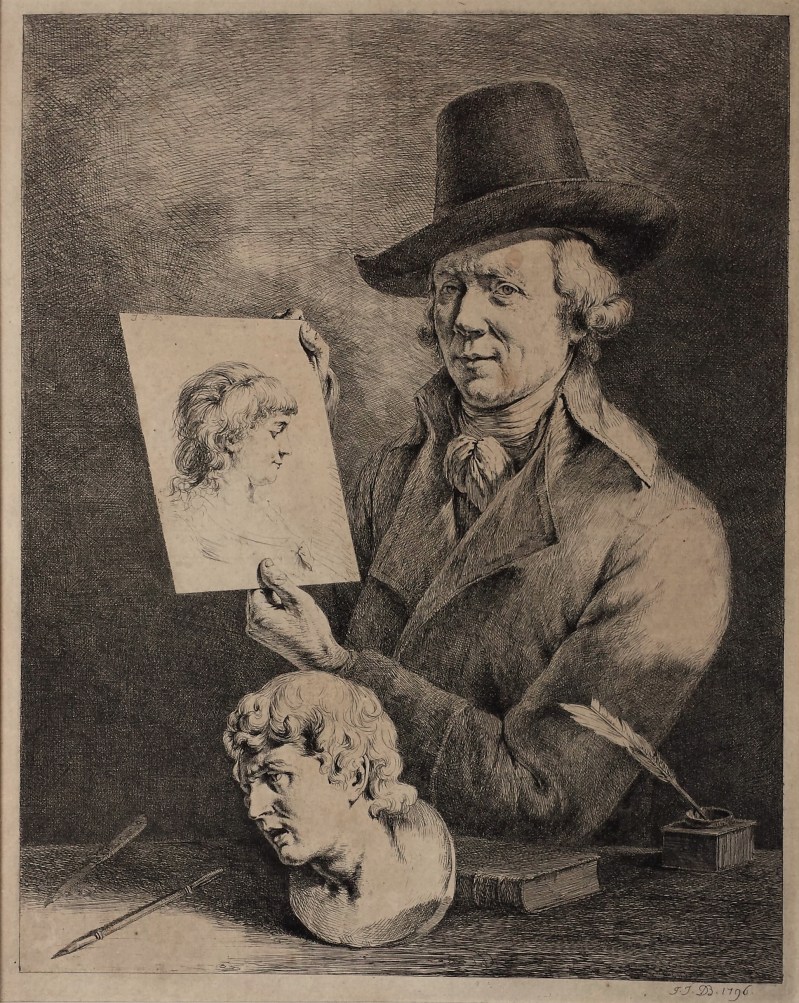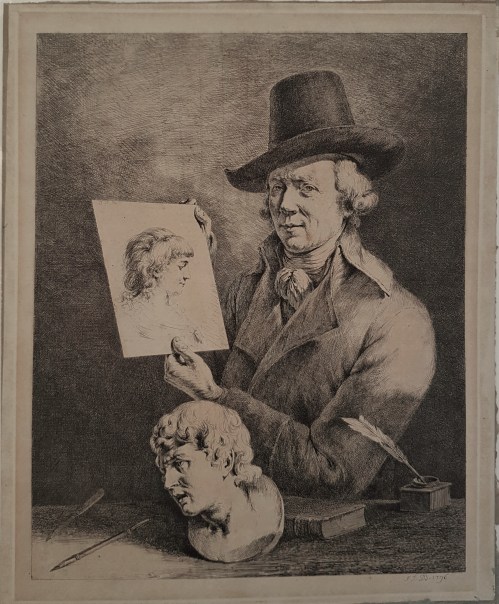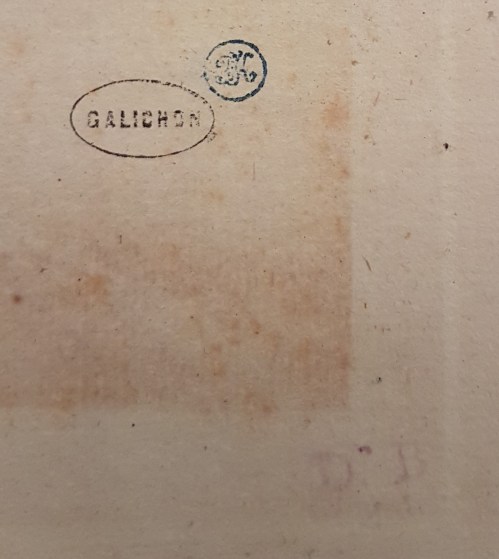Jean-Jacques de BOISSIEU: Jean-Jacques de Boissieu. Portrait of the artist - 1796
Price: € 15 000
Etching, 290/291 x 230/233 mm (to the borderline). Boissieu-Perez 102, 1st state (of 8).
Superb and very scarce impression of the 1st state (of 8) à l’eau-forte pure (only etching) before the drypoint on the shoulder and on the portrait held by Boissieu and before the roulette.
Impression printed on laid paper, trimmed inside the platemark; small margins of the copperplate (c. 16 mm all around the subject). Sheet: 322 x 266 mm. A few light foxmarks and a light mat stain in the margins of the copperplate. Two slight rubbing on the shoulder. In very good condition.
Three collection marks verso: É.-L. Galichon (Lugt 1058), F. Kalle (Lugt 1021) and D.B. (Lugt 4278).
Provenance:
- Collection Émile-Louis Galichon (1829 - 1875) (Lugt 1058). Two impressions of Boissieu’s self-portrait were sold at his collection sale (Drouot, 23-26 February 1864): one à l’eau-forte pure, one before the portrait of Boissieu's wife was changed to a landscape. The impression à l’eau-forte pure (no. 57 of the sale) was described as follows: ‘Portrait de J-J. de Boissieu, tenant un dessin où est le portrait de sa femme (R.1). Superbe épreuve d’eau-forte pure. Extrêmement rare.’ [Portrait of J-J. de Boissieu, holding a drawing with his wife’s portrait (R. 1). Superb impression à l’eau-forte pure. Extremely rare.] The buyer’s name, Amsler, is written in pencil in the margins of the copy of the sale catalogue in the collection of the Bibliothèque nationale de France. Amsler & Ruthard was a gallery selling and publishing prints in Berlin from 1860.
- Collection F. Kalle (1804 - 1875). His collection was sold in Frankfurt in November 1875 (Lugt 1021). No. 172 of the sale catalogue is L’oeuvre de Jean-Jacques de Boissieu and the first item of this lot is a ‘Portrait du maître (Rigal 1). Epreuve extrêmement rare à l’eau-forte pure’ [Portrait of the Master (Rigal 1). Extremely rare impression à l’eau-forte pure.]
- Initials D.B. printed in light violet (Lugt 4278) wasn’t identified by Lugt. They are also printed on the reverse of an impression of Passage du Garigliano by Jean-Jacques de Boissieu (Paul Prouté Gallery, Catalogue No. 100, Paris 1992, no. 291).
Impressions from the fourth state of this Portrait of the Artist are rare, but impressions from the first state are quite impossible to find. We only know of two other impressions, those mentioned by Marie-Félicie Perez: the first one is in the Edmond de Rothschild collection, in the Louvre, and the second one belongs to a branch of the Boissieu family (see catalogue p. 227). Alphonse de Boissieu, the grandson of Jean-Jacques and the anonymous author of the 1878 catalogue raisonné of the artist's prints, insists, in his foreword to the catalogue, on the rarity and particular quality of impressions 'à l'eau forte pure': “Often, after the copperplate was etched, and so as to better judge of the effect, M. de Boissieu would print a few impressions, known as eaux-fortes pures. They are few, and highly sought-after, because of their scarcity and especially because the master's skill, the precision and purity of his draughtsmanship, the assurance of his point are displayed without affectation, and finally because the copperplate, in all the vividness of the acid's bite, gives depth to the black tones of the imprints, brilliance to the light areas, and warmth to its colouring.” (Alphonse de Boissieu, foreword to the Catalogue raisonné of J.-J. de Boissieu's prints, 1878, quoted in M.-F. Perez, L’oeuvre gravé de Jean-Jacques de Boissieu, Geneva, 1994, p. 18).
The impression we present does not yet have the works in drypoint or roulette that can be noticed in later states in the background, on the shoulder of the model and on the portrait he holds in his hand (see opposite). The catalogue mentions that in this first state “the bite marks of the vices are apparent in the margins on the copperplate, in the top left corner and the bottom right corner” (Boissieu-Perez, 1994, n°102, p. 227). The margins on our impression are narrow, and so these bite marks are not visible.
Until the fourth state, J.-J. de Boissieu holds a portrait of his wife. In the fifth state, the portrait is replaced with a landscape with cows. Some have assumed this was because his wife had died, but she died in 1834, twenty-four years after him (Boissieu-Perez, 1994, p.227).
Reference: Marie-Félicie Perez: L’oeuvre gravé de Jean-Jacques de Boissieu, 1736-1810, Geneva, Cabinet des Estampes, 1994 (which reproduces and supplements the Catalogue raisonné published in 1878 by Alphonse de Boissieu).





